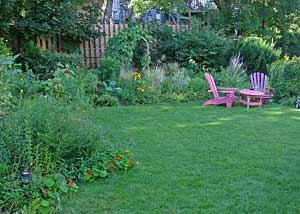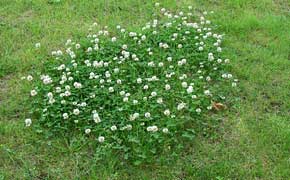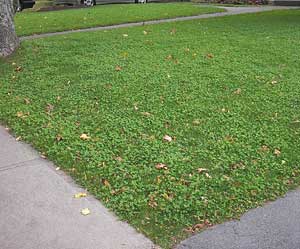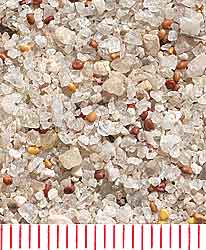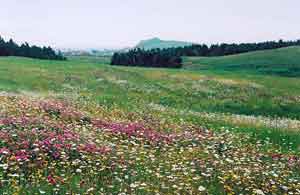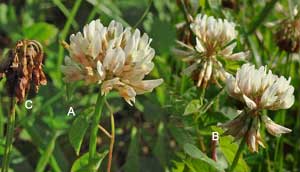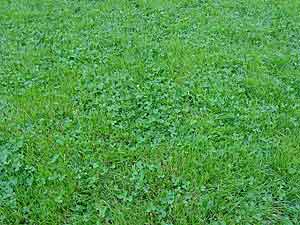Control of Chinch Bugs Without Pesticides
(www.versicolor.ca/lawns)
Introduction This page offers some suggestions for establishing and maintaining white clover in lawns. They are based on formal experiments and observations that I and students working with me have conducted on clover in Nova Scotian pastures, [L25,V43] and Halifax turfs [L6, L7, L25] , as well as on 'my "backyard experience". I have also collaborated with a local landscaping company in their development of an "organic approach", which for about 15 years now has included use of white clover.
Of course you can't use herbicides if you want clover in the lawn and some other practices of conventional lawncare, e.g., heavy use of nitrogen fertilizer, are also incompatible with maintaining clover. So there is more - at least conceptually - to establishing and maintaining clover in a lawn than just seeding it. Fortunately, in practice it involves doing less, even far less than than is involved in conventional lawncare. That may seem counter-intuitive, but think about this: some of greenest, neatest lawns one can see are those around farm houses where the only management is mowing; farmers don't waste their valuable chemicals if they can help it and most scoff at the idea of applying them to lawns! - David Patriquin
Natural invasion versus seeding
When white clover invades a lawn naturally, it develops initially in discrete clonal patches of almost pure clover, each one derived from a single plant. Because the patches stand out, they can look unsightly and often the first reaction is to get rid of them. However, if the lawn is managed to encourage clover, it will eventually be distributed throughout the lawn and, with the associated grasses and herbs, contribute to a thick turf and a pleasing mosaic of leaf textures. To accelerate this process, or to establish clover if it is not present, Dutch white clover (sometimes called Shamrock or Irish clover) can be overseeded into a turf or included with the initial seed mix for turf.
Clover species and type Spring is the best time to seed To establish clover in existing sod, sow the seed in spring or early fall. Early to mid-April before grass starts growing quickly is the best time because there is little moisture stress and little competition from grass and other broadleaf plants. Clover seed can even be 'frost seeded' in late March or early April on ground that is still mostly frozen; the seed drops into small cracks as the surface alternately thaws during the day and freezes again at night. Early sown seed will germinate when the soil starts to warm up in latter part of April (in HRM).
If the seed is sown after grass is up and growing quickly, the grass should be cut short and raked first. Seed can be mixed into the soil by raking with a stiff rake and then walking over it (or using a roller). If the seed is sown after mid-May, daily, light watering for seven to ten days (when there is no rain) will ensure good germination and initial establishment. At temperatures above 15oC, most seed will germinate in less than a week, and in as few as 2 to 3 days in summer. For several weeks thereafter, the lawn should be watered as necessary to avoid water stress. Amount of seed Jarvis [L33] advises 2 to 8 oz per 1000 sq. ft (equivalent to 61 to 245 grams per 100 sq. meters or 0.61 to 2.45 grams per sq. meter), stating that clover will be dominant at the highest rate. * Leonard [L34] suggests lower rates (0.7 to 1.4 ounces per 1000 sq ft or 21 to 42 grams per 100 sq. meters). Higher rates might be used for less favourable times of year or site conditions, lower amounts for more favourable times and sites, or on more extensive turfs where cost is a factor. *White clover seed that I have used weighed 5 to 7 milligrams per seed; the lowest seeding rate advised by Jarvis works works out to about 1 seed per 10 x 10 cm area, the highest to 4 seeds per 10 x 10 cm. For a new lawn, use about 1 part by volume of clover seed for 15 parts of grass seed. It's usually best to sow the clover seed separately from the grass seed; if it's mixed with the grass seed, the smaller, dense clover seed tends to settle out, resulting in a non-uniform, clumpy distribution of clover. Added Note: I have had many inquiries from people who have had disappointing results when they attempt to establish a pure clover lawn, i.e., they sow just clover on newly cultivated soil. You really need both clover AND grass to make a "clover lawn" as they are complementary in their ecological functioning and one supports the other. You may be able to achieve close to 100% clover initially, but it won't be maintained at 100%. If no nitrogen fertilizer is used, the clover cover will stabilize over time at about 40 to 60% of total plant cover, the balance being made up by grasses and non-nitrogen-fixing herbs. Distributing seed evenly Clover seed can be tricky to distribute evenly and there is a tendency to seed too heavily. I haven't yet seen a drop spreader or broadcast spreader that handles such small seed well. However, there may be some around:I used a small "Easy Hand-Held" broadcast-type spreader made by Scotts, and at the lowest setting (number 1) the aperature width is only about twice the diameter of a clover seed and about 3/4" long. I was able to walk the entire 200 square meter lawn area in criss-crossing patterns three to four times before I'd used up the 100 grams of seed. (I spread at a conservative 50 grams per 100 square metres)Small seeds are often coated to make them larger and easier to distribute, but I am not aware of any source of coated seed of Dutch white clover in Canada.
Mixing seed with soil is a good practice when overseeding clover into bare patches in summer. Pat the soil down and water the lawn daily for about 10 days. (It takes only 2-3 days for the clover to germinate in mid-summer.) Inoculant Clover and other legumes are infected by soil bacteria called rhizobia which form nodules on the roots. Nitrogen fixation, the process by which nitrogen gas in the atmosphere is converted into a form that us useable by plants, occurs in the nodules. If nodules, don't form, the clover will not fix nitrogen.
Fertilizers According to soil analyses, add lime to raise the pH to 6 or 6.5.[V39] Add phosphorous and potassium to bring the levels to a MEDIUM rating. Compost is a good source of phosphorous. Sandy soils may require additions of trace elements. The most important fertilizer recommendation is to use nitrogen sparingly if at all. Fish fertilizer, feather meal or compost can be used to give the grass an early-season boost before the clover starts growing vigorously; if this is done in spring time, do it early and limit the application to 0.5 lb N per 1000 sq ft (0.25 kg N/100m2). The best time to apply a nitrogen-rich organic fertilizer is late in the fall when the grass stops growing, but is still photosynthesizing. This "dormant feed" fertilization strengthens roots and encourages early greening the next spring. Apply 0.5 lb nitrogen per 1000 sq ft. (0.25 kg N per 100 m2
Clover does best in full sunlight. It generally will not persist at all in full shade, but can do OK in partial shade. My south-facing front lawn and sidewalk verges are shaded most of the day by deciduous trees. Clover thrives early in the season (before trees are fully leafed out), but by the end of summer is patchy. I overseeded with a shade tolerant grass mix and between those grasses and the clover, the lawn does fine. Mowing After sowing seed, the lawn should be mown regularly and fairly close (1.5 to 2 inches or 3.8 to 5 cm) which favors clover over grass by allowing more light to reach the clover. Once the clover is established it can be mown higher again, and should be mowed high (2.5 to 3.5 inches, or 5 to 9 cm) though the droughty months (in Halifax, generally mid-July through August). However even during droughty months, a clover/grass lawn will tolerate much closer mowing than a straight grass lawn. Clippings should be retained on the lawn for maximum retention of nutrients. Don't use Dutch white clover if you establishing a meadow rather than a lawn. In that case, use a tall-growing hay-type clover such as red clover. (A meadow is a mixture of grasses and herbs that is not mowed or is mowed infrequently, e.g., only 1 or 2 times per year.) The red flowers are also nicer in a meadow situation. Unfortunately, red clovers do not tolerate a lot of mowing, as in lawns.
Flowering In Nova Scotia, white clover starts to flower towards the end of June and goes on flowering fairly vigorously though to mid-August. Newly seeded clover generally flowers only after one full season, i.e., in the 2nd year and beyond. Once-weekly weekly mowing keeps the cover by flowers very low, which is desired by some. It takes about 4 weeks for clover seed to mature after pollination.[V54] To encourage flowering and local adaptation of the clover and other species through in situ seed production and natural selection, one can stop mowing for 4-6 weeks in mid-summer on part or all of the lawn. If the lawn is not being fertilized with nitrogen and/or excessively watered, growth of the sward will generally be very moderate during this period and the practice provides a holiday from mowing, also an interesting diversity of flowers can develop and these contribute to wildlife conservation, proliferation of natural enemies etc. Persistence and reseeding
Halifax Seed Company (www.halifaxseed.com) sells Dutch white clover seed in bulk. In 2004, I paid $5.50 for 500 grams of seed. Edmonds Landscaping and Constuction Services Ltd. in Halifax (edmonds.ns.ca) make regular use of Dutch white clover in lawns and have developed some special skills for seeding and maintaining clover in lawns. A visitor to this site mentioned a new product or class of clovers especially for lawns that has apperaed on the scene in Europe: MicroClover. I wasn't familiar with it and I don't think it is yet available in Canada, but it is available in the U.S. from Hobbs & Hopkins Ltd. in Orgeon. The marketing promotes the qualities cited for clover on this page. Hobbs & Hopkins also market a mix called Fleur de Lawn: "English daises and other small flowers combine with low-growing foliage and a special variety of dwarf perennial rye grass to create a very appealing ground cover." It's good to see such products appearing in the marketplace. Let's hope we can get them in Canada soon! (Also, 'that Canadian companies start producing their own, locally optimized mixes!)
Please forward names of any other local distributors of seed and companies that actively market white clover lawns to patriqui@dal.ca Page posted 26 May 2004 Modified 13 June 2014. |

